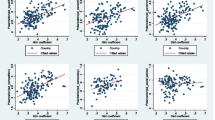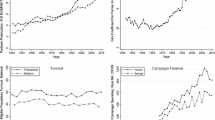Abstract
Several recent studies have suggested that the distribution of income (earnings, jobs) is becoming more polarized. Much of the evidence presented in support of this view consists of demonstrating that the population share in an arbitrarily chosen middle income class has fallen. However, such evidence can be criticized as being range-specific—depending on the particular cutoffs selected. In this paper we propose a range-free approach to measuring the middle class and polarization, based on partial orderings. The approach yields two polarization curves which, like the Lorenz curve in inequality analysis, signal unambiguous increases in polarization. It also leads to an intuitive new index of polarization that is shown to be closely related to the Gini coefficient. We apply the new methodology to income and earnings data from the U.S. and Canada, and find that polarization is on the rise in the U.S. but is stable or declining in Canada. A cross-country comparison reveals the U.S. to be unambiguously more polarized than Canada.
Similar content being viewed by others
References
Amiel, Y., Cowell, F.A.: Measurement of income inequality: experimental test by questionnaire. J. Public Econ. 47, 3–26 (1992)
Atkinson, A.B.: On the measurement of inequality. J. Econ. Theor. 2, 244–263 (1970)
Beach, C.M.: The vanishing middle class? Evidence and explanation. Mimeo, Queen’s University (1988)
Beach, C.M.: Dollars and dreams: a reduced middle class? Alternative explanations. J. Hum. Resour. 24(1), 162–193 (1989)
Blackburn, M., Bloom, D.: What is happening to the middle class? Am. Demogr. 7(1), 19–25 (1985)
Bluestone, B., Harrison, B.: The great American job machine: the proliferation of low wage employment in the U.S. economy, study prepared for the joint economic committee (1986)
Bluestone, B., Harrison, B.: The growth of low-wage employment: 1963–1986. Am. Econ. Rev. 78(2), 124–128 (1988)
Bradbury, K.L.: The shrinking middle class. N. Engl. Econ. Rev., 41–55 (1986)
Economic Council of Canada: Innovation and jobs in Canada. Economic Council of Canada, Ottawa (1987)
Fishburn, P.C., Vickson, R.G.: Theoretical foundations of stochastic dominance. In: Whitmore, G.A., Findlay, M.C. (eds.) Stochastic Dominance. Lexington Books, Boston (1978)
Foster, J.E., Shorrocks, A.F.: Poverty orderings. Econometrica 56, 173–178 (1988)
Harrison, B., Bluestone, B.: The Great u-Turn: Corporate Restructuring and the Polarizing of America. Basic Books, New York (1988)
Horrigan, M.W., Haugen, S.E.: The declining middle-class thesis: a sensitivity analysis. Mon. Labor Rev. 111(5), 3–13 (1988)
Kosters, M.H., Ross, M.N.: A shrinking middle class? Public Interest 90, 3–27 (1988)
Kuttner, B.: The declining middle. Atl. Mon. 252, 60–69 (1983)
Lawrence, R.Z.: Sectoral shifts and the size of the middle class. Brookings Rev. 3, 3–11 (1984)
Leckie, N.: The declining middle and technological change: trends in the distribution of employment income in Canada, 1971–84. Economic Council of Canada Discussion Paper #342, January (1988)
Levitan, S.A., Carlson, P.E.: Middle-class shrinkage? Across Board, 55–59 (1984)
Levy, F.: Dollars and Dreams: The Changing American Income Distribution. Sage, New York (1987a)
Levy, F.: The Middle Class: Is It Really Vanishing? Brookings Rev. 3, 17–21 (1987b)
Levy, F., Murnane, R.J.: Earnings levels and earnings inequality: a review of recent trends and proposed explanations. Mimeo (1990)
Love, R., Wolfson, M.: Income Inequality: Statistical Methodology and Canadian Illustrations. Statistics Canada, Ottawa (1976)
Maxwell, N.L.: Income Inequality in the United States, 1947–1985. Greenwood, London (1990)
McMahon, P.J., Tschetter, J.H.: The declining middle class: a further analysis. Mon. Labor Rev. 109, 22–27 (1986)
Myles, J., Picot, G., Wannell, T.: Wages and jobs in the 1980s: changing youth wages and the declining middle, July 1988, Statistics Canada, Analytical Studies Branch, Research Paper No. 17
Nygard, F., Sandstrom, A.: Measuring Income Inequality. Almqvist & Wiksell International, Stockholm (1981)
O’Higgins, M., Rainwater, L., Smeeding, T.M.: Poverty, Inequality, and Income Distribution in Comparative Perspective: The Luxembourg Income Study (LIS). Urban Institute Press, Washington, DC (1990)
Pen, J.: Income Distribution. Praeger, New York (1971)
Rosenthal, N.H.: The shrinking middle class: Myth or reality? Mon. Labor Rev. 108, 3–10 (1985)
Sen, A.: On economic Inequality. Clarendon, Oxford (1973)
Shorrocks, A.F.: Ranking income distributions. Economica 50, 3–17 (1983)
Thurow, L.C.: The disappearance of the middle class. New York Times, F.3, February (1984)
Winnick, A.J.: Toward Two Societies: The Changing Distributions of Income and Wealth in the U.S. Since 1960. Praeger, New York (1989)
Wolfson, M.C.: Stasis amid change: Income inequality in Canada, 1965–1983. Rev. Income Wealth 32(4), 337–369 (1986)
Wolfson, M.C.: Polarization, inequality and the disappearing middle. Mimeo (1986)
Wolfson, M.C.: Inequality and polarization: is there a disappearing middle class in Canada? Mimeo (1989)
Wolfson, M.C., Murphy, B.B.: Kindler and gentler: a comparative analysis of incomes of the elderly in Canada and the United States. Paper presented to the annual meeting of the North American economics and finance association, New Orleans (1992)
Author information
Authors and Affiliations
Corresponding author
Additional information
This work was supported by a Faculty Research Grant from the Canadian Government to Foster. We are indebted to Tony Atkinson for bringing us together and offering encouragement on this project. We would also like to thank Frank Cowell, Chinhui Juhn, William Novshek, Tony Shorrocks, and seminar participants at Alabama, Essex, Karlsruhe, the LSE, and Purdue for helpful comments. We are also grateful to Sabina Alkire, Peter Lambert, and Wynne Lam for help and encouragement on the final draft. This revision is identical to the 1992 version apart from typographical corrections and clarifications.
An erratum to this article can be found at http://dx.doi.org/10.1007/s10888-011-9180-5
Rights and permissions
About this article
Cite this article
Foster, J.E., Wolfson, M.C. Polarization and the decline of the middle class: Canada and the U.S.. J Econ Inequal 8, 247–273 (2010). https://doi.org/10.1007/s10888-009-9122-7
Received:
Accepted:
Published:
Issue Date:
DOI: https://doi.org/10.1007/s10888-009-9122-7




